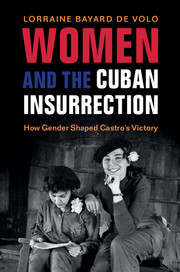Book contents
- Women and the Cuban Insurrection
- Women and the Cuban Insurrection
- Copyright page
- Dedication
- Contents
- Preface
- 1 Revolution Retold
- 2 “How Can Men Tire When Women Are Tireless?”
- 3 A Movement Is Born
- 4 Abeyance and Resurgence
- 5 Gendered Rebels
- 6 War Stories Celebrated and Silenced
- 7 “Stop the Murders of Our Children”
- 8 Masculinity and the Guerrilla War of Ideas
- 9 Women Noncombatants
- 10 Las Marianas
- 11 Past Is Prologue
- Bibliography
- Index
5 - Gendered Rebels: Barriers and Privileges
Published online by Cambridge University Press: 19 January 2018
- Women and the Cuban Insurrection
- Women and the Cuban Insurrection
- Copyright page
- Dedication
- Contents
- Preface
- 1 Revolution Retold
- 2 “How Can Men Tire When Women Are Tireless?”
- 3 A Movement Is Born
- 4 Abeyance and Resurgence
- 5 Gendered Rebels
- 6 War Stories Celebrated and Silenced
- 7 “Stop the Murders of Our Children”
- 8 Masculinity and the Guerrilla War of Ideas
- 9 Women Noncombatants
- 10 Las Marianas
- 11 Past Is Prologue
- Bibliography
- Index
Summary
As the previous chapter demonstrates, women were key figures in the movement's abeyance period (1953–56) that spanned imprisonment and exile. Moreover, during the November 1956 Santiago uprising, women comprised nearly a quarter of the twenty-five M-26-7 leaders. Yet there were no women aboard the Granma, and over the course of the insurrection's final two years, women were edged out numerically and in terms of leadership positions. This chapter begins by examining the paths that women took into the rebel forces and the barriers they confronted to address how a movement that began with relative gender equity ended as a male-dominated revolution. I approach this puzzle with an intersectional lens. Despite the rich body of intersectional research on contemporary Cuba, the Cuban insurrection has seen little research on gender, race, or sexuality, much less the intersection of these identities.
Accordingly, I first explore the means by which femininity, same-sex sexuality, and Afro-Cuban identity were devalued and politicized in 1950s Cuba. Then, drawing from diverse primary documents, I build theory on barriers to rebel women's participation, focusing on family resistance, rejection by rebel men, and low-status assignments. Turning to rebel men and masculinity, I find courage and honor to be a double-edged sword, a means of gaining masculine status, but a status that must perpetually be defended. Finally, I narrow the focus to women leaders to consider how, in the context of race, class, and age-based privilege, different expressions of femininity were valued or disparaged. Criticism lodged at Melba Hernández, a mixed-race woman, drew upon sexism and racism working in tandem. In contrast, comparing their relative (dis)advantages during the insurrection and in later representations, both Celia Sánchez and Vilma Espín benefitted from race and class privilege, yet they were differently advantaged in terms of the particular femininity they represented. While Celia was widely venerated, Vilma attracted more criticism, particularly as a power-hungry woman.
Gender, Race, and Sexuality in 1950s Cuba
The literature on gender relations in 1950s Cuba points to the division between la calle (the street and, more generally, public and political life) and la casa (the home) as men's and women's proper realm, respectively.
- Type
- Chapter
- Information
- Women and the Cuban InsurrectionHow Gender Shaped Castro's Victory, pp. 88 - 113Publisher: Cambridge University PressPrint publication year: 2018



